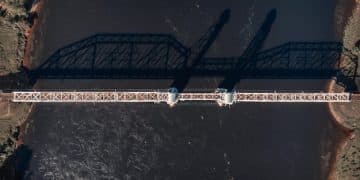US States’ Climate Resilience: Unlocking BIL Funding

The Bipartisan Infrastructure Law (BIL) presents a pivotal opportunity for US states to bolster climate resilience by strategically leveraging federal funding across various sectors, necessitating robust planning, interagency collaboration, and innovative project development to mitigate environmental risks and enhance community adaptation.
As climate change continues to reshape landscapes and impact communities across the United States, the urgency for robust climate resilience measures has never been more apparent. For US states, understanding how can US states leverage federal funding for climate resilience projects under the Bipartisan Infrastructure Law (BIL) is not merely an administrative task but a critical imperative. This landmark legislation offers an unprecedented infusion of resources, providing a unique window for states to invest in sustainable infrastructure that protects vulnerable populations and ecosystems from extreme weather events, rising sea levels, and other climate-related hazards.
Understanding the Bipartisan Infrastructure Law’s climate resilience mandate
The Bipartisan Infrastructure Law (BIL), enacted in November 2021, represents a seismic shift in federal investment toward infrastructure, with a significant, albeit often nuanced, emphasis on climate resilience. This legislative package is not overtly a “climate bill,” but its provisions are designed to ensure that the nation’s infrastructure is not only modernized but also built to withstand the increasing impacts of climate change. For states, grasping this underlying mandate is the first step toward effectively tapping into its vast financial potential for resilience projects.
Several programs embedded within BIL offer direct or indirect avenues for resilience funding. These include enhancements to existing programs and the establishment of new initiatives. The overarching goal is to reduce long-term risks to infrastructure and services, ensuring communities can adapt and thrive in a changing climate. This involves a comprehensive approach, from protecting critical facilities to restoring natural systems that offer buffering capabilities.
Core funding streams for climate resilience
BIL allocates substantial funds across various federal agencies, and many of these allocations can be leveraged for climate resilience. States need to identify which specific programs align with their unique climate vulnerabilities and resilience priorities. This often requires a deep dive into program guidelines and eligibility criteria, which can sometimes be complex due to the interdisciplinary nature of climate resilience work.
- Department of Transportation (DOT) programs: Funding for resilient roads, bridges, and public transit systems, including specific grants for protecting infrastructure from extreme weather.
- Federal Emergency Management Agency (FEMA) programs: Enhancements to pre-disaster mitigation programs like the Building Resilient Infrastructure and Communities (BRIC) program, which supports states, local communities, tribes, and territories in undertaking hazard mitigation projects.
- Environmental Protection Agency (EPA) initiatives: Investments in water infrastructure, including projects that enhance drought resilience, improve wastewater treatment in flood-prone areas, and protect water quality from climate impacts.
Beyond these direct avenues, many other smaller, targeted programs contribute to the broader resilience effort. States should consider a holistic view of infrastructure and environmental policy when seeking out opportunities. The law encourages an integrated approach, recognizing that climate resilience touches nearly every sector of public infrastructure and service delivery.
Ultimately, the BIL underscores a federal commitment to a more resilient future. States that proactively align their climate adaptation strategies with the law’s provisions will be best positioned to secure the necessary funding. This involves moving beyond reactive disaster responses toward proactive, forward-looking investments that minimize future harm and build stronger, safer communities in the face of climate uncertainty.
Developing comprehensive state-level climate resilience strategies
Securing federal funding under the Bipartisan Infrastructure Law (BIL) for climate resilience projects necessitates more than just identifying available grants; it requires states to develop and articulate comprehensive, forward-thinking resilience strategies. These strategies serve as the foundational blueprint, demonstrating a state’s understanding of its unique climate vulnerabilities, its commitment to addressing them, and its capacity to execute impactful projects. A well-articulated strategy not only guides effective resource allocation but also significantly strengthens a state’s position in competitive funding processes.
A truly comprehensive strategy begins with a thorough assessment of climate risks and vulnerabilities, leveraging the latest climate science and local data. This involves identifying which regions, communities, and infrastructure assets are most susceptible to specific climate hazards, such as sea-level rise, extreme heat, wildfires, or intense precipitation events. Understanding these localized impacts is crucial for tailoring resilience interventions that are both effective and equitable.
Key components of an effective strategy
An effective state-level climate resilience strategy should integrate several critical elements, ensuring a holistic and actionable approach. It moves beyond theoretical concepts to define concrete actions and measurable outcomes.
- Vulnerability assessments: Detailed analysis of climate threats and their potential impacts on specific geographies, populations, and critical infrastructure, often incorporating mapping and modeling tools.
- Prioritized project pipelines: A clear identification of resilience projects, ranked by urgency, impact, and feasibility, ready for immediate application when funding opportunities arise.
- Community engagement: Mechanisms for involving local communities, including frontline and underserved populations, in the planning and implementation process to ensure projects meet real-world needs and foster local buy-in.
Furthermore, a robust strategy should outline specific goals and metrics for evaluating progress, ensuring accountability and enabling data-driven adjustments. This includes setting targets for reducing flood risk, improving drought resilience, or enhancing ecosystem services that mitigate climate impacts. The strategy should also consider interdependencies among various sectors, recognizing that a resilient transportation network, for instance, is intrinsically linked to resilient energy systems and emergency services.
States must also cultivate a culture of adaptation, fostering innovation in governance and policy. This means exploring new regulatory frameworks, adapting building codes, and integrating climate considerations into state capitol improvement plans. The strategy should be a living document, subject to periodic review and revision as climate science evolves and new challenges emerge.
By investing time and resources into developing these well-defined resilience strategies, states are not just preparing for federal funding applications; they are building the long-term capacity needed to protect their citizens, economies, and natural environments from the escalating threats of a changing climate. These strategies are the bedrock upon which successful federal funding procurement and project implementation stand.

Navigating the application process: Tips for success
The sheer volume of new federal funding opportunities under the Bipartisan Infrastructure Law (BIL) can be both promising and daunting for US states. Successfully navigating the application process requires more than just a good project idea; it demands strategic planning, meticulous preparation, and a deep understanding of federal agency requirements. For states aiming to secure funds for climate resilience, optimizing their application approach is paramount to converting potential into tangible investments.
One critical aspect of the application process is early engagement with federal agencies. States should not wait for official grant solicitations to be released. Proactively reaching out to program officers at agencies like FEMA, EPA, and DOT can provide invaluable insights into forthcoming priorities, funding cycles, and specific requirements. This engagement allows states to tailor their proposals to directly address federal objectives, increasing their chances of success.
Crafting a compelling proposal
A compelling proposal moves beyond simply listing project activities; it tells a persuasive story about need, impact, and capacity. Federal reviewers look for proposals that are clear, concise, and demonstrate a strong understanding of both the climate challenge and the proposed solution. Moreover, they seek evidence of thorough planning and a realistic budget.
- Data-driven justifications: Support all claims with robust data on climate impacts, population vulnerability, and project benefits. Quantify potential returns on investment where possible, such as avoided damages from extreme events.
- Clear project scope and goals: Define objectives, activities, and expected outcomes with precision. Vague language can undermine a proposal’s credibility.
- Demonstrated partnerships: Highlight collaborations with local governments, community organizations, tribes, and private sector entities, as these often add strength and legitimacy to resilience projects.
Moreover, states should emphasize the “shovel-readiness” of their projects. Proposals that are well past the conceptual stage, with preliminary designs, environmental assessments, and community support already in place, often receive preferential treatment. Federal agencies are keen to fund projects that can swiftly move from approval to implementation, demonstrating immediate impact and efficient use of taxpayer dollars.
Finally, robust fiscal management and reporting capabilities are essential. Federal grants come with stringent accounting and compliance requirements. States must demonstrate their ability to manage funds responsibly, track expenditures transparently, and report on project progress effectively. A solid track record of grant management or a clear plan for developing such capacity can instill confidence in federal reviewers.
By focusing on early engagement, crafting meticulous and persuasive proposals, demonstrating project readiness, and ensuring strong fiscal accountability, US states can significantly enhance their ability to leverage BIL funding for critical climate resilience initiatives, turning federal investment into protective infrastructure and secure communities.
Prioritizing equitable and community-led resilience solutions
For US states seeking to leverage federal funding under the Bipartisan Infrastructure Law (BIL) for climate resilience, a critical lens must be placed on equity and community leadership. The impacts of climate change disproportionately affect underserved communities, including low-income neighborhoods, communities of color, and indigenous populations, who often have fewer resources to prepare for and recover from extreme weather events. Federal programs increasingly emphasize fair distribution of benefits and the meaningful involvement of these communities, making equitable and community-led solutions not just morally imperative but also a strategic advantage in securing funding.
Prioritizing equity means more than simply allocating a portion of funds to vulnerable areas. It involves a fundamental shift in how resilience projects are conceived, planned, and implemented. This entails genuinely engaging with community members to understand their lived experiences, specific vulnerabilities, and locally-defined needs. Such an approach ensures that resilience solutions are culturally appropriate, address root causes of vulnerability, and build long-term community capacity rather than imposing top-down solutions.
Involving diverse stakeholders for maximum impact
Effective community-led resilience projects thrive on genuine collaboration and the inclusion of a wide array of voices. States should proactively seek out and invest in partnerships that reflect the diversity of their populations and expertise. This includes:
- Direct engagement with grassroots organizations: Partnering with local non-profits, community development corporations, and environmental justice groups who have established trust and relationships within specific neighborhoods.
- Tribal consultation and collaboration: Ensuring full and meaningful consultation with sovereign tribal nations on projects that affect their lands, cultural resources, or members.
- Inclusion of local knowledge: Valuing and incorporating traditional ecological knowledge and local insights alongside scientific expertise to develop more robust and context-specific solutions.
Furthermore, states should consider how resilience projects can generate co-benefits beyond climate adaptation. For instance, a green infrastructure project designed to manage stormwater runoff might also create new park spaces, improve air quality, and provide local job opportunities. These “multiple benefit” projects are often highly attractive to federal funders because they address several societal challenges simultaneously, maximizing public investment.
Empowering communities also involves providing technical assistance and capacity-building resources. Many small, rural, or underserved communities lack the technical expertise, grant-writing skills, or planning resources required to compete for complex federal grants. States can play a crucial role by offering direct support, connecting communities with planning resources, or developing regional consortia to share expertise and streamline applications.
By centering their climate resilience efforts on equity and genuine community leadership, US states can ensure that federal funding not only builds robust infrastructure but also fosters social justice, strengthens community bonds, and creates a more resilient future for all residents, especially those who have historically borne the brunt of environmental burdens.
Leveraging data and technology for enhanced resilience planning
In the evolving landscape of climate change, effective resilience planning in US states highly depends on sophisticated data analysis and the strategic deployment of cutting-edge technologies. For states aiming to fully leverage federal funding under the Bipartisan Infrastructure Law (BIL), moving beyond anecdotal evidence to data-driven decision-making is not merely an advantage; it’s a necessity. Modern tools and approaches can significantly enhance a state’s ability to identify vulnerabilities, quantify risks, model future scenarios, and monitor the effectiveness of resilience interventions.
Data forms the bedrock of credible climate resilience strategies. This includes historical climate data, current environmental conditions, demographic information, infrastructure inventories, and economic impact data. Integrating these diverse datasets allows states to create a more accurate and comprehensive picture of their climate risks. Furthermore, predictive modeling enables states to anticipate future climate impacts, such as evolving floodplains or areas prone to increased drought, facilitating proactive rather than reactive planning.
Technological tools for better decision-making
A range of technological tools are now available that can revolutionize how states approach climate resilience. Investing in these technologies, and the skilled personnel to operate them, can lead to more efficient, impactful, and defensible resilience projects. These technological advancements not only streamline the planning process but also strengthen grant applications by providing quantifiable evidence of need and anticipated outcomes.
- Geographic Information Systems (GIS): Powerful platforms for mapping and analyzing spatial data, allowing states to visualize vulnerability hotspots, track environmental changes, and model the impacts of various resilience strategies.
- Remote sensing and satellite imagery: Provides high-resolution data on land use change, vegetation health, water levels, and infrastructure damage, crucial for monitoring conditions and assessing project effectiveness.
- Climate modeling and forecasting software: Tools that project future climate scenarios, enabling states to design infrastructure and policies that are robust against a range of potential climatic conditions.
Beyond these, emerging technologies like artificial intelligence (AI) and machine learning (ML) are beginning to offer new frontiers in resilience. AI can analyze vast datasets to identify complex patterns and predict vulnerabilities with greater accuracy, while ML algorithms can optimize resource allocation for emergency response or long-term adaptation projects.
However, simply acquiring technology is insufficient. States must also invest in building the human capacity to effectively use these tools, from data scientists and GIS specialists to planners and policymakers who can interpret the insights generated. Data-sharing agreements and interoperability between different state agencies and local governments are also vital to ensure that information flows freely and informs decision-making across all levels.
By embracing data analytics and advanced technologies, US states can elevate their climate resilience planning from reactive measures to proactive, scientifically informed strategies. This not only makes their federal funding applications more competitive but also ensures that investments are targeted, effective, and deliver maximum protective value in the face of escalating climate challenges.

Fostering interagency collaboration and public-private partnerships
Effective climate resilience in US states, especially when leveraging the substantial federal funding available through the Bipartisan Infrastructure Law (BIL), hinges significantly on robust interagency collaboration and the strategic formation of public-private partnerships. Climate impacts do not respect jurisdictional boundaries, nor are they confined to a single sector; floodwaters affect transportation, energy, and housing simultaneously. Therefore, a fragmented approach to resilience planning and project implementation is inherently inefficient and limits a state’s capacity to fully capitalize on federal investment opportunities.
Interagency collaboration involves breaking down silos within state government, ensuring that departments responsible for transportation, energy, environmental protection, public health, and emergency management work cohesively. This integrated approach allows for a holistic view of climate risks and enables the development of comprehensive solutions that leverage diverse expertise and resources. It also streamlines the application process for complex federal grants that often require multi-sectoral approaches.
Benefits of collaborative models
Collaborative models extend beyond state-level agencies to include local governments, regional planning commissions, and tribal nations, creating a more cohesive and impactful resilience ecosystem. This expanded collaboration offers numerous advantages:
- Resource pooling: Combining funding streams, human resources, and technical expertise from various agencies and partners to undertake larger, more impactful projects than any single entity could manage.
- Knowledge sharing: Facilitating the exchange of best practices, lessons learned, and innovative solutions across different sectors and levels of governance, accelerating the adoption of effective resilience strategies.
- Streamlined planning and implementation: Reducing redundancies, resolving conflicting priorities, and accelerating project timelines by fostering a shared understanding of goals and responsibilities.
Public-private partnerships (PPPs) offer another vital pathway for augmenting resilience efforts. Private sector entities can bring innovation, capital, and execution efficiency to complex infrastructure projects. Utility companies, for example, have a vested interest in grid resilience, while real estate developers may finance green infrastructure that mitigates flood risk. States can structure these partnerships to incentivize private investment in resilience, sharing both risks and rewards.
Moreover, engaging academic institutions and non-profit organizations can add significant value. Universities can provide cutting-edge research, technical assistance, and workforce development, while non-profits often have deep community ties and expertise in local adaptation efforts. These partnerships can also enhance a state’s appeal to federal funders, demonstrating a broad base of support and innovation.
Ultimately, by fostering strong interagency collaboration and strategically embracing public-private partnerships, US states can create a more resilient future. These collaborative frameworks enable states to maximize the impact of BIL funding, ensure that resilience projects are comprehensive and sustainable, and build a collective capacity to withstand and adapt to the increasing challenges posed by a changing climate.
Measuring impact and ensuring long-term sustainability
Securing federal funding for climate resilience projects is only one part of the equation; ensuring that these investments yield tangible, long-term benefits and are sustained beyond the initial grant period is equally critical. For US states leveraging the Bipartisan Infrastructure Law (BIL), establishing robust mechanisms for measuring impact and planning for perpetual sustainability is essential. This not only demonstrates accountability to federal funders and taxpayers but also ensures that resilience efforts continue to protect communities over time, adapting to evolving climate threats.
Measuring impact involves defining clear metrics and regularly assessing whether projects are achieving their intended outcomes. This goes beyond simply tracking expenditures to evaluating whether the resilience measures are effectively reducing risks, protecting assets, and improving community well-being. Baselines should be established before project implementation to allow for accurate measurement of changes over time.
Key aspects of sustainability and performance assessment
Long-term sustainability requires strategic planning that considers ongoing maintenance needs, future funding sources, and adaptive management. Resilience projects are not one-time fixes; they require continuous attention and potential adjustments as climate conditions change. States should integrate sustainability considerations throughout the project lifecycle, from initial design to post-completion evaluation.
- Performance indicators: Develop specific, measurable, achievable, relevant, and time-bound (SMART) indicators to track project effectiveness, such as reductions in flood damages, improved water availability, or decreased recovery times after extreme events.
- Maintenance and operations planning: Allocate resources and establish clear responsibilities for the ongoing upkeep of resilience infrastructure, ensuring its continued functionality and longevity.
- Adaptive management: Implement a framework for periodically reviewing project performance against evolving climate data and adjusting strategies or interventions as necessary to maintain effectiveness.
Furthermore, states should explore diversification of funding for long-term sustainability. While BIL provides a significant initial boost, relying solely on federal grants is not a viable long-term strategy. This could involve creating dedicated state or local resilience funds, exploring innovative financing mechanisms like green bonds, or leveraging private sector investment through resilience-focused PPPs. User fees where appropriate, or storm water utilities might also contribute to O&M funds. Incentivizing private sector resilience measures through tax breaks or regulatory support can also lessen the burden on public funds.
Regular reporting and transparency are also vital for demonstrating accountability and building public trust. States should clearly communicate the successes and challenges of their resilience projects, sharing data and lessons learned with stakeholders. This transparency can also help in securing future funding rounds by showcasing a track record of effective project management and positive impact.
By prioritizing impact measurement and long-term sustainability, US states can ensure that the substantial investments made possible by the Bipartisan Infrastructure Law translate into enduring resilience. This forward-looking approach safeguards communities from future climate challenges, delivering maximum enduring value from every federal dollar invested.
| Key Aspect | Brief Description |
|---|---|
| 📊 Data-Driven Planning | Utilize robust data and tech (GIS, climate modeling) to identify vulnerabilities and project impacts effectively. |
| 🤝 Collaborative Partnerships | Foster interagency cooperation and public-private alliances for comprehensive, cross-sectoral solutions and resource pooling. |
| 🌍 Equitable Solutions | Prioritize community-led approaches, ensuring benefits reach vulnerable populations and address local needs holistically. |
| ⏳ Long-term Sustainability | Develop maintenance plans and diversify funding to ensure continued project effectiveness and adaptation over time. |
Frequently asked questions
BIL funding supports a wide array of projects, including green infrastructure (e.g., permeable pavements, rain gardens), coastal restoration, wildfire mitigation, flood protection (e.g., levees, natural wetlands), drought preparedness, and modernization of infrastructure like roads, bridges, and energy grids to withstand extreme weather. Eligibility often depends on specific program guidelines, but the scope is broad to address diverse climate threats.
To enhance competitiveness, states should focus on data-driven proposals demonstrating clear need and impact, highlight strong interagency and community partnerships, underscore project readiness for immediate implementation, and align closely with federal funding priorities. Early engagement with federal agencies and meticulous attention to application requirements are also crucial for success.
Local communities are central to successful resilience efforts. States are encouraged to engage directly with local governments, community organizations, and residents to identify needs, co-develop solutions, and ensure projects are equitable and locally relevant. Many federal programs prioritize projects with strong community input and local leadership, often empowering local entities to directly apply or partner with state agencies.
Yes, numerous resources exist. Federal agencies (FEMA, EPA, DOT) often provide technical assistance, webinars, and detailed guidance documents for their programs. Organizations like the National Association of State Energy Officials, the National Governors Association, and various climate resilience non-profits also offer tools, workshops, and direct support to help states and local entities navigate BIL opportunities and grant applications.
Sustainability planning is paramount. While BIL provides initial funding, projects must have clear strategies for long-term operation, maintenance, and potential adaptation to evolving climate conditions. Federal agencies increasingly scrutinize proposals for their long-term viability, looking for diverse funding streams beyond the initial grant, robust maintenance plans, and mechanisms for ongoing performance monitoring and adaptive management to ensure enduring resilience.
Conclusion
Ultimately, the Bipartisan Infrastructure Law represents a transformative moment for US states to fundamentally reshape their resilience to climate change. The pathway to effectively leveraging this federal funding is multi-faceted, requiring not only a deep understanding of available programs but also a strategic commitment to comprehensive planning, equitable community engagement, data-driven decision-making, and strong collaboration across all levels of governance. By embracing these principles, states can transition from reactive responses to proactive, sustainable adaptation, ensuring their citizens, economies, and natural environments are better equipped to face the inevitable challenges of a changing climate. The opportunity is now, and the responsible stewardship of these resources will determine the strength of our collective future.





